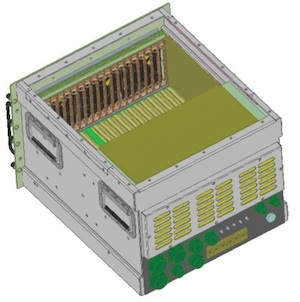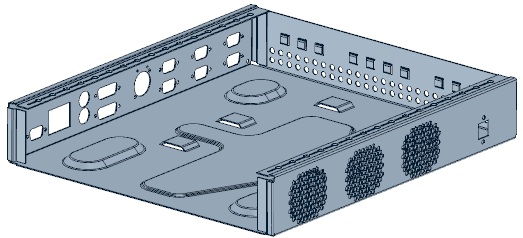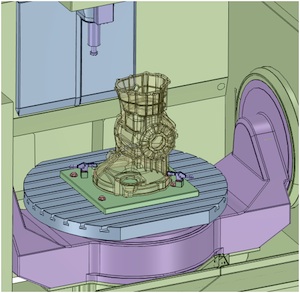Latest News
October 5, 2011
By Anthony J. Lockwood
 SpaceClaim’s Blake Courter |
SpaceClaim has been an interesting outfit since it launched. It was clear to me out of the gate that they were going to do things differently, although, I must admit that, at first, they struggled to explain just what they were up to. Nothing surprising with that. Start-ups stumble and grope their way all the time. Can’t say that about SpaceClaim any more. These people know what they’re doing and, judging by the fact that everyone is talking about direct modeling, all the other guys recognized that they’re on to something big too.
But you can still say that SpaceClaim is an intriguing developer. After all, they develop a 3D direct modeling application not to knock parametric modelers out of business but to expand mechanical CAD throughout the design chain so that your business can expand. A good example of that is the way analysts can use SpaceClaim to prep a file for analysis without having to disrupt the detailed design work. And now with the recent introduction of SpaceClaim Engineer 2011+, the company takes its enterprise CAD idea a step further with a big step into CAM.
I had a chance to fire off a few questions through e-mail to Blake Courter, the customer development director at SpaceClaim. What I got back surprised me: candid responses instead of canned responses. Here’s what went down:
Lockwood: Let’s get right down to it: Why direct modeling? Why not choose a CAD system that gives you a hybrid approach so that you have the power and richness of parametric design as well as the speed and flexibility of direct modeling?
Courter: Do you mean “why pure direct modeling,” like SpaceClaim? Only a pure solution can deliver the necessary simplicity to make a tool an order of magnitude easier to learn and use. We’ve clearly achieved that: over 80% of our customers learn SpaceClaim with no paid or other formal training. You see, the challenge to learn a tool is in part the user interface and in part the data model. The real challenge with feature-based modelers is that the data model is so complicated you need to dedicate your career to it to be proficient. If you add direct modeling to those systems, there’s even more to learn.
A marketing VP at a major CAD company recently demonstrated refreshing honesty when he said their addition of direct modeling to their feature-based modeler was only to bring the benefits of direct modeling to their existing customer, not to address a new market. We let anyone answer basic questions and explore design ideas in 3D.
It’s also important that we are entirely dedicated to making everything easy with direct modeling. We’re not distracted by other problems, which lets us do it all in one simple solution.
Lockwood: One of your marketing positions is that SpaceClaim enables engineers to rapidly create and modify 3D models to produce better responses to RFPs (request for proposals) and achieve higher win rates. How so? I mean anyone can create a pretty picture. What edge would SpaceClaim give a company competing for a bid beyond creating a pretty picture quickly? Do you have anything to back up this assertion?
Courter: I didn’t believe this one either until I interviewed a few customers. In fact, it was SIE Computing Solutions—they engineer rugged electronic packaging solutions—that I realized that bid modeling is a different business from concept modeling. I was talking to one of their sales engineers. His job is to write proposals in response to RFPs. He had 15 years’ experience using their heavy-duty in-house CAD system, and he wanted to introduce 3D into their sales process. Their traditional process had been to respond to a custom proposal with some images from their catalog and a promise of the required specs. Although they’d been using 3D for years on the CAD side, their sales process was still 2D.
 The image shows a modified version of a standard product that was included in a proposal responding to a custom statement of work. Image courtesy of SpaceClaim Corp. |
With SpaceClaim, they could open the native customer CAD data that specified where their component needed to fit. SIE could read the closest design from their PLM system and insert it in the right space in the customers’ design, adjust the chassis to fit, and rearrange the internals as necessary. If custom parts needed to be added, they could design them, cost them, and add them to the BOM. They could perform simulation up-front on the concept, removing risk. When they were done, they could send the concept to the customer in 3D, and it would automatically pop up in the right place in their assembly as a placeholder, so everyone on the customer’s design team would be designing around their component.
So far, what the guy was telling me seemed like a nice new twist on a concept modeling story. But then I asked if this had any impact on his business.
“Oh yeah,” he says. “We used to win bids 50% of the time, now we win them 80% of the time.”
I’ve been in the CAD business my entire career and never heard a success like that. In the detailed design world, the benefits of one CAD system vs. another are measurable but not revolutionary. But using 3D to have extended conversations with customers, encourage real-time design reviews, accurately pinpoint costs, and outsell your competitors? That’s something that blew me away. It’s an entirely different value proposition. But there were benefits to engineering as well: Since they had their ducks in a row with a well-fleshed out concept, their engineering costs were 30% lower.
It’s a great story from a small manufacturer in Brockton, MA. When you talk to CEOs from companies like this, it shows them how 3D can change the way they do business in the global market. It raises the visibility of engineering software to a new level.
Editor’s note: You can download the full story of how SpaceClaim changed the RFP process at SIE Computing Solutions here, registration free, or register for an on demand webinar on ow SpaceClaim can help your RFP process here.
So that’s where this type of positioning comes from. We heard this type of story a few times, learned something, and documented it for the rest of the world.
Lockwood: SpaceClaim has made in-roads in the world of CAE analysts by giving them a platform with which they can easily import and defeature models for their simulations. Now with the August release of SpaceClaim Engineer 2011+, you’re eyeballing CAM users. SpaceClaim Engineer2011+ has a bunch of features for sheet metal work. What got you into this? What do you bring to CAM users?
Courter: We didn’t exactly follow the standard playbook for a CAD start-up, did we? We entered the market in the high-end, catering to the needs of engineers such as simulation users who weren’t well-served by in-house CAD systems. We worked closely with large manufacturers and well-established partners to deliver performance on large assemblies, handle real geometry, and repair models that other CAD systems broke. We built more of an engineering tool than a traditional CAD tool. It’s worked out really well.
Now we’re seeing a new shift. It turns out that traditional feature-based modelers are getting increasingly complicated and are not as cost-effective as we are for a lot of everyday CAD work. Smaller manufacturers are frustrated with rebuild errors keeping them at work past midnight. There are a lot of businesses that just want to ship parts and see any time spent in CAD as waste. And there are a lot of designers who just want to get the job done and not play chess with their CAD system all day. SpaceClaim brings to these people that kind of everyday practicality to the table. You don’t need to send your team to SpaceClaim training. Just take it home and add water
 A sheet metal part with form features and lightweight holes. Image courtesy of SpaceClaim Corp. |
To make sure we were industrial strength for manufacturers, we got together with trusted experts who understood their business. First, Flow Corp started using us as the geometry front-end for their water jet cutters. And we have an incredible partnership with Trumpf. Among other things, they’re a world leader in sheet metal fabrication machinery. They’ve helped us take sheet metal farther than it’s ever gone before. For example, we have push-button tools to add modern sheet metal features such as water-tight corners, hinges, double-walls, and custom forms.
Feature-based CAD has stagnated in sheet metal, but the machine tools have seen a lot of innovation. We can help you get the most out of your machine because direct modeling is a key ingredient here. We can convert models from anywhere into our sheet metal parts, because we aren’t encumbered with history the way feature-based CAD tools are. If you’ve ever done feature-based sheet metal, you know that it’s an awkward paradigm. Direct modeling feels a lot more natural.
Editor’s note: You can register for an on-demand webinar on SpaceClaim’s sheet metal capabilities here.
Lockwood: What’s next on the manufacturing front and when can users and potential users expect to see it? Got a sneak preview?
Courter: Well, we just shipped our second major release of the year, 2011+, which was very focused on manufacturing customers and partners. I can’t go into specifics for the next release, but we’re going to continue to identify areas where existing tools are not satisfactory and we can create real value. We’ll also be rounding out capabilities that our customers ask for. In fact, let me shout out to customers: If you have any enhancement requests, let us know. We’re pretty much 100% customer- and partner-driven, but we need to have your ideas on the list!
 Setting up a fixture for a work cell in SpaceClaim. Image courtesy of SpaceClaim Corp. |
Lockwood: If I am VP at some company, how do I determine whether or not I should upgrade to direct modeling or upgrade my parametric modeler?
Courter: It can be difficult to tell. Walk around and see if you hear folks swearing at their CAD system or complaining about staying late or working weekends to get designs done. Many designers have dedicated their careers to CAD, have become certified professionals in one system or another, and can be scared to change the way they do things. Also, feature-based modelers have notorious interoperability problems, and the thought of introducing a new 3D tool can give certain folks the screaming meanies.
In many cases, I would not advocate changing how you do detailed design. Feature-based CAD can be fine. But talk to your simulation users, your sales engineers, the guys on the shop floor. You’ll find that there are often more opportunities to eliminate waste surrounding feature-based CAD with direct modeling than there are replacing it.
Lockwood: SpaceClaim is not the only developer of direct modeling software out there, so if I’m that VP why should I choose you over the other guys?
Courter: We have an unfair advantage in that SpaceClaim is the only mechanical design system developed in the past decade. Even the Windows-based tools introduced in the 1990s are now old enough to vote. We have been able to take advantage of modern multi-core processors and develop an interactive experience that no one else has achieved. In doing so, we’ve created the lowest TCO ]total cost of ownership] and highest ROI ]return on investment] in the history of CAD.
But SpaceClaim is also a different kind of company. We’ve put customer value first, and we’ve been successful because we realize that we have as much to gain from learning from our customers and partners as they do from deploying our product. I think it’s that attitude more than anything else that’s caused the attention we’ve received, and I’m proud to be a part of it. All I can ask is that you take a look and find out for yourself.
DE Editor at Large Anthony J. Lockwood writes about engineering computing and other matters with the aid of two dogs and a cat from his home in Dallas. You can contact him c/o mailto:[email protected].
Subscribe to our FREE magazine, FREE email newsletters or both!
Latest News
About the Author
Anthony J. Lockwood is Digital Engineering’s founding editor. He is now retired. Contact him via [email protected].
Follow DE





